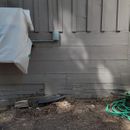Best practices for metal siding that doesn’t sweat/condense, Zone 5
Hi community, I have a question about metal siding. We are looking at installing continuous external insulation when replacing a water-damaged 5×13 section of wall (the above-ground portion of an exterior basement wall, unheated, unfinished, laundry/mechanical room only). Zone 5, snowy northern california mountains, very dry summers.
What are best practices for installing metal siding in a snowy place, where snow is likely to fall off the roof and pile against this siding (it’s dangerous to shovel it away until the roof is clear). My top priority is avoiding mold, condensation, etc. (we just finished an expensive mold remediation job on this basement and want to avoid every having to do that again).
That particular section of wall, we’re looking to do all the insulation on the outside and keep the basement laundry room unfinished. Looking at having plywood sheathing, tyvek (is drainable better?), XPS 1 inch, rainscreen, siding (and is metal the best choice here). Is it best that the insulation be integrated with the metal, instead of separated from it by a rainscreen (for example, to choose foam-backed metal?)
How can we fully avoid the risk of condensation on metal siding in this scenario.
We’re also looking at replacing the bottom section of the basement wall on the other side of the house, where snow also piles up, and the bottom siding is cracked on almost every board. However, that side is by the finished living room (which has drywall and fluffy insulation), so leaning towards not having c.i. there unless we determine for certain that there’s no vapor barrier inside and that there’s not more than 2×4-level of insulation there. Would metal be a good choice there, and how would we prevent condensation in that scenario?
Thanks!
GBA Detail Library
A collection of one thousand construction details organized by climate and house part











Replies
I would say that a generously-sized rain screen gap is the most important element. Preferably one vented at both the top and bottom. Exterior insulation should be in contact with the rest of the wall assembly. Using a drainable housewrap between the foam and WRB (or using a dimpled or crinkled WRB) will allow for drainage rather than trapping water.
Thanks -- would the rain screen gap be between the metal and foam (as it is for other types of siding)? Or should we use foam that is attached to metal such as foam-backed steel siding https://www.becn.com/productDetail/C-609558/609577 ?
The exterior insulation should be in contact with the rest of the wall assembly. If you locate your rain screen gap between the foam (or foam/metal composite) and the rest of the wall assembly, the foam will do nothing for you. Thus the gap should be between the metal and foam.
Thank you -- would it be a similar wall assembly as we'd have with fiber-cement (i.e. CDX Plywood, drainable tyvek homewrap, foamular XPS or similar, wood furring strips 1x4 which create an airgap, siding? Would the contact between the furring strips and the metal be problematic? Thanks!
Yes the same assembly should work well.
Thanks, and is this assembly with metal at least as likely or more likely to avoid mold, than using Fiber-cement would? Can such an assembly handle snow? Thanks!
Both are similar in that the material itself does not support mold growth, but if there is a source of moisture and food--i.e., dust--mold can grow. Resistance to snow load depends on the gage of the metal and how closely spaced the furring/rain screen strips are.
Thanks! For resisting snow and having a good amount of rain screen for ventilating the siding, how close furring strips would be ideal? Are there any particular metal siding products you recommend? Thanks!
I have only used metal siding three times in the last ten years. I think we used MBCI brand on one or more but I can't say for sure; the builder might have substituted something else. I would start by deciding what kind of profile you want. Furring strips are usually 16" o.c. but it will depend on the metal gage and the manufacturer will probably have requirements.